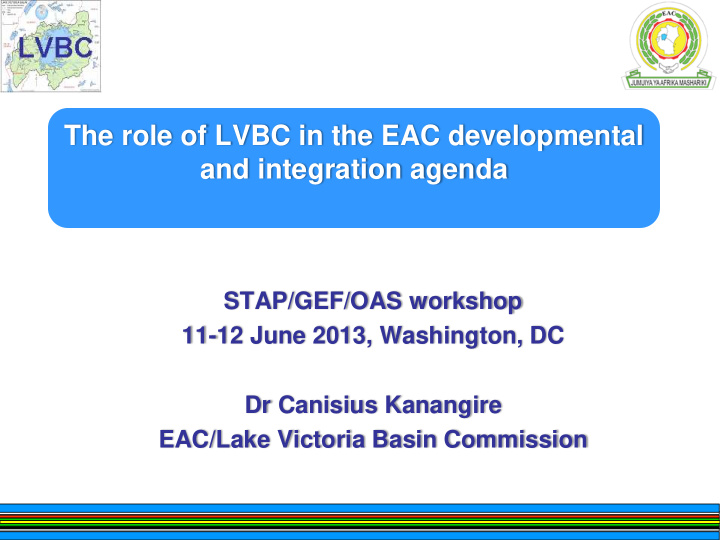



The role of LVBC in the EAC developmental and integration agenda STAP/GEF/OAS workshop 11-12 June 2013, Washington, DC Dr Canisius Kanangire EAC/Lake Victoria Basin Commission
LVB REGION
Values of LV and its Basin 1. Largest inland water and fishing sanctuary 2. Major inland water transport linkage 3. Source of water-domestic, industrial and commercial 4. Reservoir for hydropower generation 5. Major climate modulator in the region 6. High Biodiversity reservoir 7. Tourist attraction sites 8. Minerals – Gold and Diamonds 9. Population
Lake Victoria and its basin 1. Lake Victoria (LV) is the single most important shared and treasured resource that defines the EAC 2. LV is one of the main focal areas of cooperation among the three Partner states of EAC 3. LV Basin is designated as a “Regional Economic Growth Zone” to be exploited jointly
LVB main challenges and issues 1. Changing Water Quality 2. Biodiversity Decline esp. fish 3. Emergence of water hyacinth 4. Pollution loading (urban & municipal) 5. High deforestation rates (illegal & legal) 7. Catchment degradation (poor agric practices) 8. Drainage of critical wetlands 9. Silt loading into the Lake 10.Dropping Water Levels (recent development)
Degradation of natural resources T
Challenges: overfishing and pollution • OFFLOADING FISH – NOTICE THE BLUE GREEN ALGAE
Lake Victoria Basin Commission: Legal perspectives The Treaty for the establishment of the EAC of 1999, Chapter 19, Article 114, 2(b), iv provided for the LVBC set up The Protocol for Sustainable Development of Lake Victoria Basin Under Article 33 & 34 of the provides for the establishment of Lake Victoria Basin Commission as an institution of the East African Community
Lake Victoria Basin Commission o An institution of EAC established through a Protocol o Mandate: coordinate sustainable development in LVB in line with the provisions of the Protocol o Objectives is to promote: Equitable economic growth Measures aimed at eradicating poverty Sustainable management of Natural Resources Environmental protection Compliance to safety of navigation o Governed by a Sectoral Council of Ministers for LVB
Scope of LVBC mandate Population Water quality Land, forests & Water quantity & Pollution wetland degradation & water balance Social & Biodiversity economic status Land & fisheries productivity
Scope of LVBC mandate: areas of cooperation Areas of Cooperation …….. Areas of Cooperation • • Sustainable development and Improvement in public health; management of water • Promotion of research, capacity resources and fisheries; building and information • Promotion of sustainable exchange; agricultural and land use • Environmental protection and practices and forestry; management of the Basin; • Trade, commerce and • Promotion of public participation development of industry; in planning and decision • Development of infrastructure making. and energy; • Maintenance of navigational security and safety;
GOVERNANCE STRUCTURE EAC Summit Civil Society/ Sectoral EAC Council Private Council of of Ministers Sector Ministers National LVBC Coordination Focal Point Secretariat Committee Office Donor Sectoral Consultative Committees Group
GOVERNANCE STRUCTURE • Operationally, under Article 34 of the Protocol the Structure is: • Sectoral Council • Coordination Committee • Sectoral Committees • Secretariat of the Commission • The functions of each of the above are detailed in Articles 35 – 42 of the Protocol • Seat of the Commission: Kisumu, Kenya
PROJECTS AND PROGRAMMES PROJECT & FOCUS DEV. PROGRAMME PARTNERS LVEMPII NRM, ENVIRONMENT DEGRADATION, WB, GEF,SIDA POLLUTION, INVASIVE WEEDS (LOTIC & LENTIC) MERECP BIODIVERSITY, LIVELIHOODS (LOTIC) NORWAY, SWEDEN EALP PARTNERSHIP IN HIV/AID CONTROL SWEDEN, USAID MRB-BHH BIODIVERSITY & HUMAN HEALTH USAID PFP CATALYTIC PROJECTS ON SWEDEN, SUSTAINABLE DEV. FINLAND LVWATSAN WATER SUPPLY & SANITATION AfDB SSNP HYDROGRAPHIC SURVEY, MSCLV, OIL SIDA SPILL CONTIGENCY PLAN, PIRACY
Main Challenges – still 1. Many stakeholders with diverse interests 2. Several programmes and projects are being implemented independently 3. Efforts duplication (lack of synergies) 4. Weak legal and Institutional frameworks to regulate the resource utilization 5. Weak enforcement of existing laws 6. High expectations: Increasing call for tangible results
CONCLUSION o Increased acceptance of LVBC as a relevant player in EAC socio-economic development and integration process o Increasing political support and sustained financial support from partner states o The Commission benefits a lot from being part of a (vibrant) REC o Need for more responsiveness to expectations (regional coordination, resource mobilisation, regional planning, regional policy development and harmonisation, Knowledge and information mgt, ...)
Recommend
More recommend